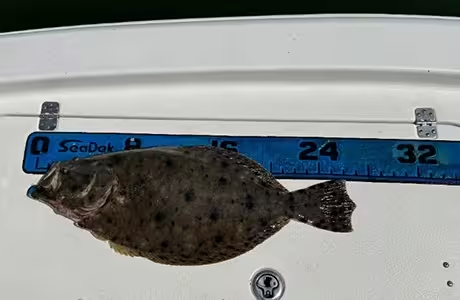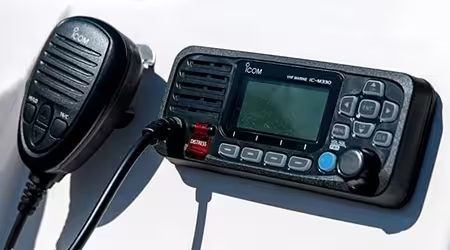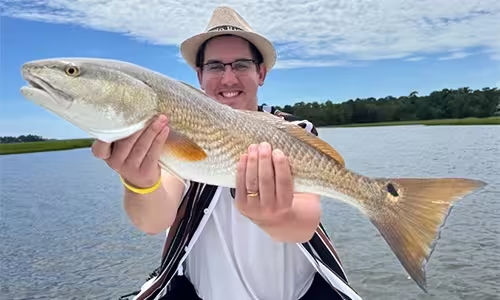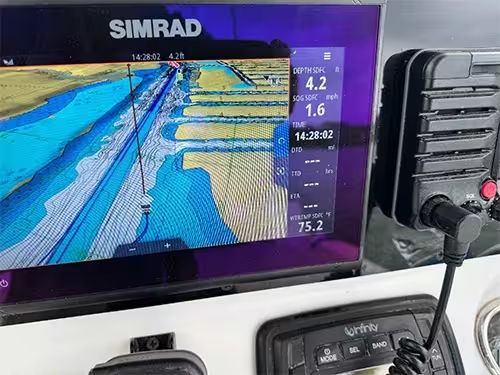
Every angler has a “magic” spot or a go-to lure. Maybe it’s the creek bend where you caught your personal-best bull redfish, or a lure that fooled a trophy trout on a perfect fall morning years ago. Those memories are powerful—and it’s natural to chase them—but fishing doesn’t typically work that way. Water, bait, and fish are always changing. Lean on your past experience, yes, but don’t get stuck fishing the past. Be ready to try new spots, new lures, and new techniques.
I call this the success bias trap —letting past wins override today’s conditions. I see it all the time, across all skill levels, and breaking it can turn a slow day into a great fishing trip.
As a full-time guide in Ocean Isle Beach, NC, with more than 25+ years as a fishing guide, I’ve watched this play out often. Anglers ask for their “lucky” spot or want to use the same lure all day, but success comes from reading the moment and not replaying the past. Here’s how success bias works, why it hurts, and how to beat it.
What Is Success Bias in Fishing?
Success bias is a mental trap that happens when we let past wins drive our fishing decisions instead of current conditions. It’s not just about fishing the same spot over and over—it’s also about sticking to one lure, one color, or one presentation style because it worked once.
It’s natural to lean on a lure or spot that once produced, but when confidence becomes stubbornness, it becomes a trap. Success bias isn’t about one lure or spot—it’s about relying on yesterday’s wins instead of today’s conditions.
Last year, my go-to flounder lure for much of summer and fall was a Z-Man Swimming Trout Trick in Root Beer and Chartreuse, fished with a hopping or jigging action along the bottom. That pattern crushed fish in 2024, but this year it’s been a different story. Murkier water conditions have made that color less effective, and the warmer summer temperatures have pushed us toward much slower presentations—literally dragging soft plastics on the bottom. If I’d stubbornly stuck to last year’s confidence bait and style, I would’ve struggled badly with my flounder fishing charters this season. Instead, adapting has paid off; as this summer has produced many more quality flounder for me than last year.
So, I caution you against fishing memories, not patterns. Fish aren’t static. They react to bait movement, tide cycles, weather changes, and seasonal shifts. What worked last week—or even yesterday—may not work today. Feel free to give it a try, but don't get stuck there, or claim the bite is off, when it doesn't work like you expected.
I see this in action a lot with topwater fishing. There’s nothing like the thrill of watching a trout or redfish explode on a surface plug, so when an angler has a good day with topwater, they understandably want to replicate it. The problem is that topwater lures shine in certain conditions, like low light conditions when fish are active, and they can be completely ineffective in other scenarios. Still, many anglers will throw them all day -and in any season- because they can’t shake the memory of that one epic strike. That’s success bias in action.
Beware of Secondhand Success Bias

Success bias doesn’t just come from your own memories; it can also come from what other anglers tell you. Maybe your buddy crushed trout last week in a certain creek, or you heard a call on the VHF radio about a hot bite at a certain reef. It’s tempting to run straight to that spot expecting the same results, but this often leads to frustration.
Conditions change daily, and a bite window can close quickly. By the time you get there, the tide may have shifted, the bait may have moved, and the fish may have relocated. There’s nothing wrong with checking out a spot based on a tip, but don’t get locked into someone else’s success story.
Use secondhand information as a starting point, not a guarantee. The best anglers gather intel, then get to work figuring out the pattern themselves for that day. That ability to adapt will always outfish a rumor or yesterday’s report.
Whether it’s your own past success or secondhand reports from other anglers, bias often blinds us to changing conditions. To really break free, it helps to understand exactly why fishing spots and lures stop producing. Here are some of the biggest reasons I see patterns fall apart, and why being able to read and adapt to these changes is key to catching more fish.
Why Your Favorite Spot or Lure Stops Producing
5 Reasons Your Favorite Fishing Spot or Lure Isn’t Working
- Tide Changes: Fishing spots turn on and off with the tide. What was perfect on a falling tide may be dead on an incoming one.
- Seasonality: Fish move with water temperature and bait migrations. Your winter trout honey hole likely won’t hold them in July.
- Bait Movement: If the bait isn’t there, then gamefish won’t be either.
- Fishing Pressure: Community fishing holes get hammered; fish get spooky or move.
- Presentation Bias: Even if you’re in the right spot, using the wrong lure or retrieve for the conditions can shut down your success. Likewise, poor boat positioning can force bad casting angles, making your lure look unnatural. Additionally, faster presentations won't work well in colder water or extremely hot water. Pick your lures and presentation method based on the current circumstances.

The Captain’s Approach: Reading Conditions, Not Just GPS Marks
On my charters, I rarely fish the exact same location two days in a row. Instead, I approach each day like a clean slate. Here’s what I look for:
- Tide Stage: Where is the water level, and how is the current flowing? Fish positioning is heavily influenced by tide.
- Wind Direction and Weather: A strong wind can muddy water in one area and clear it in another.
- Bait Activity: If I don’t see baitfish flicking or shrimp skipping, I know I need to move. You should always be looking for signs of life.
- Water Clarity and Temperature: Clear, cool water calls for different tactics than stained, warm water.
- Structure: Fish relate to oyster bars, docks, grass lines, and drop-offs differently depending on all the above factors.
Electronics help me confirm what I already suspect, but they’re not my starting point. My experience is built from thousands of hours on this water, constantly observing how fish respond to the current conditions. That’s how I put clients on fish even when the “hot spot” is empty.
Practical Tips to Break Out of the Trap
One of the best lessons I can teach is to “fish the moment.” That means making decisions based on what’s happening right now, not what worked last month or last season. Fishing is about pattern recognition, but patterns change with conditions. Be present for, and mindful of, what is happening now.
Here’s how to break out of success bias in fishing:

- Switch Presentations Intentionally: If a bait isn’t getting bites, change size, color, or style. A slow day isn’t always a location problem—it could be that you’re showing the fish the wrong presentation. Likewise, if you're getting short strikes, your presentation is close to what the fish want, so you know you're almost dialed in and a small tweek should make all the difference.
- Let Conditions Guide Your Lure Choices: Early morning low light might be great for topwater, but as the sun rises, switch to a soft plastic or hard bait. Don’t force-feed fish a lure that's not working.
- Keep Multiple Rods Rigged: Having different setups ready lets you adjust quickly when conditions shift.
- Scout New Water: Dedicate time to exploring new creeks, docks, or structure, even if you sacrifice numbers that day. This builds long-term knowledge. If you're a Charter Captain, then use one of your own personal fishing days to hit new water instead of your favorite spot. You might find that you have a new favorite spot.
- Take Notes: A simple fishing log will help you connect conditions to fish behavior. Over time, you’ll see trends that make you less reliant on a single spot or lure.
“Fishing the moment” is a skill that separates successful anglers from frustrated ones. Once you learn to trust your observations and instincts, you’ll spend more time catching and less time guessing. It's still fishing, you'll still have less productive days, but there will be fewer of them.
Choosing the Right Fishing Gear and Tools to Help You Plan and Adapt
The best way to avoid “fishing the past” is to show up prepared. Have a plan, rig a few different setups, and use tools that help you read what’s happening that day instead of relying on yesterday’s success.
Local Fishing Reports and Tackle Shop Tips
Skip the social media fishing reports. Stop by a local tackle shop and tell them what species you're interested in and then ask questions about good locations, water color/clarity to expect, bait presence and size, and the tide stage that’s been most productive. Treat any spot, pattern, or lure tips as a starting point, not a guarantee. A couple of great tackle shops in my area for good info are Dave's Outpost in Sunset Beach and Rigged and Ready Fishing Center in Holden Beach.
Also, for Brunswick County NC fishing reports, read my fishing reports to calibrate your plan before you head out on your fishing trip. You can also refer back to articles from the same period for previous years, but be careful to not place too much of your plan into fishing history.
Another great resource for fishing reports in North Carolina is the Fisherman's Post.
Best Fishing, Weather, and Mapping Apps for Anglers
Apps are great for planning, but they shouldn’t replace what you see and feel on the water. Use them to forecast and frame a plan, and then let the fish and conditions confirm or redirect you.
- Google Earth Google Earth is an excellent starting point for inshore anglers looking to scout new fishing spots. Check imagery from different years to see the same area at various tide levels —this can reveal oyster bars, sand flats, and other key structure. Once you spot a promising area, switch to Navionics to confirm whether the water depth is safe for your boat before making the run and then mark the waypoint on your fish finder.
- Navionics SD Mapping Card This is what I use in my Simrad fish finder. It offers: 3D View, Aerial Photos, Dock-to-dock Route Guidance, Relief Shading, Satellite Imagery with SonarChart Shading Overlay, Sonar Imagery, and SonarChart Live Mapping Feature. Most importantly, I can see the bottom contour and depth before I pass over an area, which means I'm safer and more efficient on the water.
- Tides Near Me or NOAA Tides — identify your bite windows and when to hop creeks or banks.
- Windy forecasts for: wind speed/direction, wave height/period/direction, surface water temps, etc...
Recommended Fish Finders
Electronics should confirm what conditions suggest, not dictate every move. Pair chart study with sonar to find similar areas that fit today’s tide, water color, and wind—don’t just chase last week’s waypoints.
- Simrad GO9 XSE — SideScan for edges and bait lanes; down scan to verify fish on structure. This is the exact unit on my boat and I love using it.
- Garmin Livescope Bundle — Although I don't use it, this is everything you need if you want to give livescope a try.
- Save waypoints by pattern (tide + wind + clarity), not just by GPS location and a random name. Name them with context so you can replicate, not repeat.
Essential Fishing Gear for Adapting on the Water
Rig multiple rods so you can pivot quickly when you're not getting bites. Confidence in your lure is great, but options are better. This is a decent list of inshore fishing options you may not have considered, but should try.

- Top Water: MirroLure Top Dog Jr
- Swimbaits: Z-Man Swimming Trout Trick, 3.5" & Z-Man Diezel Minnow, 5"
- Searchbaits: Strike King Redfish Magic Spinnerbait & Z-Man Chatterbait
- Twitchbait: C17MR Pro Series MirrOdine
- Finesse Bait: Z-Man Salty Ned Shrimpz, 2"
- Scented Soft Plastics: Berkley Gulp! Shrimp, 3"
- Attractants: Pro Cure
- Slip Floats: Billy Boy Slip Float
- Popping Corks: Bomber Paradise Popper X-Treme Popping Cork
- Jigheads: Dr Fish Jigheads Stock various sizes: 1/8, 3/16, 1/4 oz and maybe just 1-2 colors. Eyes are important. If you only stock one, get a 3/16 ounce natural, red, or black jighead with eyes and a strong hook. This particular brand holds plastics onto the jighead really well.
- Keep spare jigheads, terminal tackle, and leader spools handy so you can make quick changes. I have them in a "day box" at my console.
One word of caution: don’t go overboard with variation. Have a plan and give each lure a fair shot before making major changes. Bass anglers use the term “junk fisherman” to describe someone who constantly switches baits and techniques throughtout the day. That approach can work, but it can also backfire if you never let a pattern develop. Be ready to adjust, but don’t be so quick on the draw that you hurt your chances in the long run.
Build a Learning Habit
A simple log turns “random luck” into repeatable patterns. Record: water temp, clarity, tide stage, wind, bait presence/size, location type, and what actually got bit (size, color, speed, and angle). Then compare against my latest fishing reports to spot shifts week to week.
Quick Prep Checklist
- Check tide/wind for your time window and pre-mark 3–5 pattern-fit areas (not just old spots).
- Call a local shop for water color + bait notes; use tips as general pattern info, not 100 percent keyed in on the destinations.
- Rig 3–4 rods for top, mid, and bottom —be prepared to vary retrieve styles and speeds.
- Rig leader lengths and jig weights to match clarity/current.
- Review your last log entry and skim the fishing reports to set expectations.
Remember: these are tools, not rules. Let the day’s conditions make the final call.
Tools to Help You Succeed Anywhere
Technology has made fishing more accessible and efficient than ever. SideScan sonar, mapping software, GPS waypoints, and Navionics charts are incredible tools. They help me plan trips, find structure, and understand bottom contours that would otherwise take years to discover.
But like anything else, they’re just tools. Over-reliance on them can become its own kind of success bias—believing the fish only exist where your screen shows them.
Don’t Let Your Electronics Become a Crutch

I’ve had plenty of days where my sonar showed nothing, but I trusted my gut and found fish. I’ve also seen anglers so locked on their electronics that they miss obvious signs on the surface, like bait moving or even birds diving.
Forward-facing sonar has sparked debate in the fishing world. While some anglers see it as unsporting, I believe it’s just another tool. The key is not to let it replace instinct and observation.
Electronics should complement your skills, not replace them. If you want to become a well-rounded angler, spend as much time learning how to read current seams, tide swings, and bait movements as you do learning your electronics.
Bringing It Back to Ocean Isle Beach
Our local waters here in Ocean Isle Beach, Sunset Beach, Holden Beach, and Calabash are constantly changing. Inshore fishing is a game of tides and seasons. A flat that was hot last week may be barren today because of bait movement, and your go-to trout bank might not produce when salinity shifts after a heavy rain.
Hiring a guide isn’t just about catching fish that day—it’s about shortening your learning curve. When you fish with me, if you want, I can teach you how to read the water, not just fish one waypoint. My goal is to help you become a better angler so you can succeed anywhere.
FAQs
How often do professional charter captains fish the same spot?
We may revisit areas that hold fish consistently under certain conditions, but we move often and fish patterns, not just locations.
How do I know when to leave a spot?
If you’ve been there 15–20 minutes without a bite, and you don’t see bait or activity, it’s time to move.
When should I change lures or presentations?
Anytime conditions shift: light levels, tide, or water clarity —or if you’ve cast the same lure for 20 minutes without a bite.
Is forward-facing sonar cheating?
It’s a powerful tool, but it’s not magic. Skill, timing, and experience still matter more than electronics.
Why do fishing spots stop producing fish?
Because conditions change constantly —bait movement, tides, water temperature, salinity, and fishing pressure all influence where fish hold.
Learn to Fish the Moment, Not the Memory
Breaking out of success bias is one of the best ways to level up your fishing. Whether you’re here in Ocean Isle Beach or fishing somewhere else, focusing on “fishing the moment” instead of chasing memories will put you ahead of most anglers.
If you’re ready to take your fishing to the next level, book a fishing charter with me at Salty Dawg Fishing Charters. I’ll show you how to read water, adapt quickly, and find fish under all conditions—skills that will serve you for a lifetime.

Tight Lines,
Captain Harvey Wall
Salty Dawg Fishing Charters
August 29, 2025